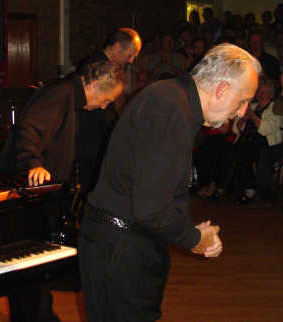Ian Hockley kindly sends this review, with his own concert pictures, to 'Beyond the Pale':
|
|
The Jacques Loussier Trio
Percussion:
Bass: |
Prelude in C major – Bach |
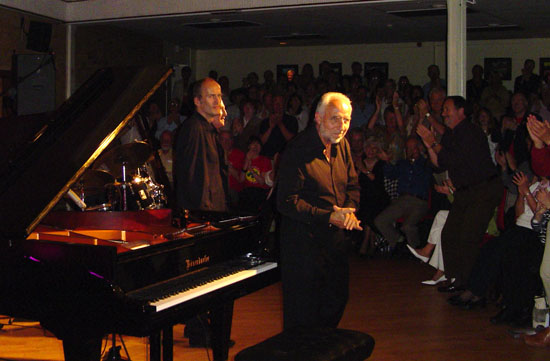 It is
8 February 1996, and Gary Brooker is seated at a black Steinway
model D piano and explaining to a packed Barbican Hall in London about the
apparent genesis of A Whiter Shade of Pale, borne out of his attempts
at playing by ear the version of Bach’s Air on a G string recorded
circa 1960 by a jazz piano trio.
It is
8 February 1996, and Gary Brooker is seated at a black Steinway
model D piano and explaining to a packed Barbican Hall in London about the
apparent genesis of A Whiter Shade of Pale, borne out of his attempts
at playing by ear the version of Bach’s Air on a G string recorded
circa 1960 by a jazz piano trio.
Growing up as a child in the 1970s and, like so many in these isles reared on a diet of fish fingers, Slade and Doctor Who, the aforementioned version of the Bach Air burned its way into my musical consciousness at a very early age, due to its heavy, almost daily, exposure on British television right through the sixties and seventies as the accompaniment to a series of often-amusing commercials for cigars.
This smouldering, languid rendering of Air on a G string, a movement taken and adapted from an orchestral suite by baroque meister Johann Sebastian Bach, became one of the most recognisable pieces of music in the country. Surprisingly, very few people seem to have been aware who recorded it.
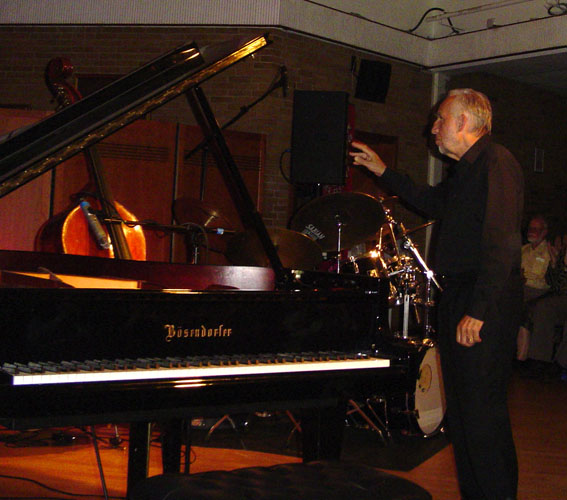 The
musician who did was a French jazz pianist, Jacques Loussier (born 1934)
who achieved phenomenal international success with his
Play Bach trio
during the late 1950s and early 1960s, sold about six million albums and
then effectively 'retired' for many years, virtually disappearing from the
concert stage.
The
musician who did was a French jazz pianist, Jacques Loussier (born 1934)
who achieved phenomenal international success with his
Play Bach trio
during the late 1950s and early 1960s, sold about six million albums and
then effectively 'retired' for many years, virtually disappearing from the
concert stage.
My affection for the cheap opiates it purported to promote has long since disappeared, but Air on a G string remains; it was arguably the first piece of jazz I ever heard, probably the first piece of Bach, and it instilled in me a love of both.
Brooker and co. came along a little later for me, but it is surely no exaggeration to say that Jacques Loussier and his recordings of Bach were of incalculable importance on the early development of Procol Harum in general and in the writing of A Whiter Shade of Pale in particular.
Twelve years after listening to the Brooker patter in the Barbican and almost exactly a year since I heard Air on a G string resound around the hallowed walls of St John’s Smith Square at the head of Procol Harum’s fortieth-birthday concert rendition of their biggest hit, I found myself about twenty miles out of London in the Kent countryside in the Aisher Hall in Sevenoaks, listening to the Frenchman who obliquely started so much.
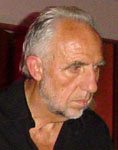 Jacques Loussier
reformed his trio in the Bach tercentenary year in 1985 and returned to live
performance; he now gives a very small
handful of concerts each year, around the globe, and this was a rare
appearance in Britain.
Jacques Loussier
reformed his trio in the Bach tercentenary year in 1985 and returned to live
performance; he now gives a very small
handful of concerts each year, around the globe, and this was a rare
appearance in Britain.
Wrapping up the Sevenoaks Festival as the headline act – and there wasn’t a spare seat in the house – this was one those uncommon occasions where the hackneyed epithets 'legendary' and 'genius' were properly applicable.
The concert started with Bach’s C major Prelude, arguably Jacques Loussier’s biggest 'hit' after the Air, and one might like to conjecture that Gary Brooker had the Frenchman’s elegant recording in his consciousness when it came to interpolating a large chunk of the Bach C major prelude into Repent Walpurgis on the eponymous black album.
The rest of the evening was really a master class in music-making at international level; the house, including myself, were riveted throughout the whole evening. Rarely have I seen an audience so utterly spellbound and silent during a performance. The first half concentrated on improvisations on Bach themes, the second half explored other composers.
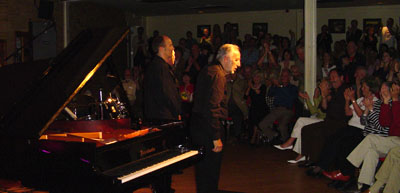 Arguably, no living jazz
pianist produces a classier or more refined sound from the piano, and
cutting a dapper figure in black, Loussier has lost none of his accuracy and
agility. With great economy of body and finger movement he let fly with
some incredibly loose and free improvisations, particularly in the climactic
Bolero. His rhythm section are mightily impressive too: drummer
André Arpino pulled off the near-miraculous feat of sustaining Ravel’s
insistent pat-a-pat rhythm for nearly twenty minutes while using his
remaining hand and two feet to improvise around every corner of his modest
drum kit; and Benoit Dunoyer de
Segonzac’s fluid bass work produced some incredibly lengthy, melodic and
inventive solos.
Arguably, no living jazz
pianist produces a classier or more refined sound from the piano, and
cutting a dapper figure in black, Loussier has lost none of his accuracy and
agility. With great economy of body and finger movement he let fly with
some incredibly loose and free improvisations, particularly in the climactic
Bolero. His rhythm section are mightily impressive too: drummer
André Arpino pulled off the near-miraculous feat of sustaining Ravel’s
insistent pat-a-pat rhythm for nearly twenty minutes while using his
remaining hand and two feet to improvise around every corner of his modest
drum kit; and Benoit Dunoyer de
Segonzac’s fluid bass work produced some incredibly lengthy, melodic and
inventive solos.
An immaculate Air on a G string inevitably produced the biggest cheer of the night: and at the CD signing session afterwards I was tempted to ask the Frenchman if he was aware of what he had started. I remained content that in a Procol Harum sabbatical year at least I had the opportunity to see and hear for the first time one of my all-time musical heroes, by any standards one of the greatest living jazz pianists, and, to boot, one who had such a seminal influence on the composition of A Whiter Shade of Pale.
Without the crucial subliminal magnetism of Jacques Loussier’s jazz cool, Procol Harum’s early days and first recording sessions would surely have been different. It is a cause for celebration that he is still alive and well, and playing very well indeed.
